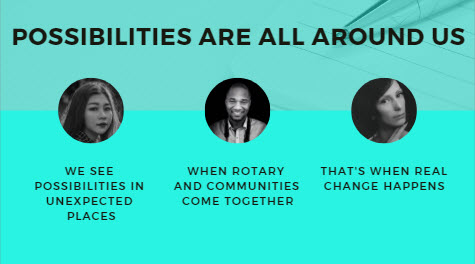What is Community Service?
What is Community Service?
Community Service is the opportunity Rotary clubs have to implement club projects and activities that improve life in the local community. Every Rotary club and every Rotarian assumes a responsibility to find ways to improve the quality of life for those in their communities and to serve the public interest. When Rotary is viewed as a positive force in the community, its membership strengthens and grows, adding to the organization's ability to serve worldwide.

Community Service:
- Encourages and fosters the ideal of service to the personal, business and community life of every Rotarian.
- Provides opportunities for every Rotarian to exemplify “Service Above Self”.
- Provides a chance to respond to the needs of a local community.
Effective Community Service projects:
- Are relevant to the community
- Serve as a learning experience for Rotarians
- Help identify a Rotary club’s role in its community
- Respond to real issues
- Offer more than a “quick fix”
- Improve community members’ lives
- Incorporate the abilities of those who are served
- Recognize the contributions of all participants
- Are supported by members of the Club
Questions to ask BEFORE starting a Community Service project:
- Is there a Need? Have you confirmed, and reconfirmed that need? How?
- What problem are you solving? How are you improving a situation?
- Who will benefit? How?
- Can your Rotary club really help? Do you have the resources? The people? The finances? The time? The capacity based on the size and scope of the potential project?
- Is there ‘buy in’ from the members? Have all of the questions been answered. Have their concerns been addressed? Have you voted on it?
- Does your club have a skills inventory or matrix of members? Do you actually have the competencies required within your club to execute this project? Perhaps this is your opportunity to recruit a member(s) who can bring these competencies into your club.
- Does the project fit in with other club activities? Does it dovetail with the strategic plan of the club?
- Does this project fit in with Rotary’s SIX areas of focus? The most successful and sustainable Rotary service projects do tend to fall within one of the following six areas:
- Peace and conflict prevention/resolution
- Disease prevention and treatment
- Water and sanitation
- Maternal and child health
- Basic education and literacy
- Economic and community development
- Who in the club will ‘champion’ this project? Is it an individual, or a team? The project has much more chance of success when it has a team of Rotarians behind it.
- Is this a one year project or a continuing project? How have you planned for sustainability?
- How much funding is required? Where will that come from?
- Do you have a detailed plan for the success of this project?
- Will the project generate good publicity for the club? Who will be responsible for this?
- What other community resources are available? What other organizations should be involved? Is this an opportunity for “High Impact Collaboration”?
- Could another Rotary club partner with your club to make this project a success?
- Are your members passionate about doing this project, or only lukewarm in their response to it? You need passionate people for a successful project.
- What are the necessary steps to move this project forward?
- Has a timeline been created?
- Do you have a communication and PR strategy?
- How will you measure success?
- Do you need a more comprehensive assessment done? Click here for more
STEPS to be taken when starting a Community Service project:
- Refer to the list above “Questions to ask before starting a Community Service project”
- Identify the NEED (provide support information) Can include third party information, statistics, newspaper articles, to support your pitch to your club members if you need to.
- Consider your club ‘culture’ – consider service history, previous record of project successes and failures, individual member interests
- Approach your club with a PLAN (not an IDEA) BUY-IN is Key! How can you get buy-in?
- Stress the BENEFITS – for the target group/recipients/participants; the community; the club
- Address CONCERNS – Time, costs, level of involvement or commitment, size of project! Emphasize cost benefit ratio. Address them before they become questions from membership.
- How does the project fit in with other club activities? Try to make connections.
- Identify those who are committed to accomplishing the task. Make certain that they are on board and passionate about the project.
- Include in your PLAN – Scope of Project; Budget and funding; Work Plan; Timeline; Communication and PR Plan.
- Anticipate questions and address them in your presentation to your club.